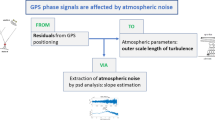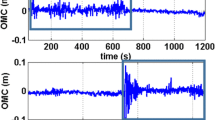Abstract
When processing observational data from global navigation satellite systems (GNSS), the carrier phase measurements are generally assumed to follow a normal distribution. Although full knowledge of the probability distribution of the observables is not required for parameter estimation, for example when using the least-squares method, the distributional properties of GNSS observations play a key role in quality control procedures, such as outlier and cycle-slip detection, in ambiguity resolution, as well as in the reliability assessment of estimation results. In addition, when applying GNSS positioning under critical observation conditions with respect to multipath and atmospheric effects, the validity of the normal distribution assumption of GNSS observables certainly comes into doubt. This paper illustrates the discrepancies between the normal distribution assumption and reality, based on a large and representative data set of GPS phase measurements covering a range of factors, including multipath impact, baseline length, and atmospheric conditions. The statistical inferences are made using the first through fourth sample moments, hypothesis tests, and graphical tools such as histograms and quantile–quantile plots. The results show clearly that multipath effects, in particular the near-field component, produce the dominant influence on the distributional characteristics of GNSS observables. Additionally, using surface meteorological data, considerable correlations between distributional deviations from normality on the one hand and atmospheric relative humidity on the other are detected.







Similar content being viewed by others
References
Abdi H, Molin P (2007) Lilliefors test of normality. In: Salkind NJ (ed) Encyclopedia of measurement and statistics, vol 2. Thousand Oaks, CA, USA
Amante C, Eakins BW (2009) ETOPO1 1 Arc-Minute Global Relief Model: procedures, data sources and analysis. NOAA Technical Memorandum NESDIS NGDC-24. Boulder, CO, USA
Anderson TW, Darling DA (1952) Asymptotic theory of certain “goodness-of-fit” criteria based on stochastic processes. Ann Math Stat 23:193–212. doi:10.1214/aoms/1177729437
Boehm J, Werl B, Schuh H (2006) Troposphere mapping functions for GPS and very long baseline interferometry from European Centre for Medium-Range Weather Forecasts operational analysis data. J Geophys Res 111:B02406. doi:10.1029/2005JB003629
Cai J, Grafarend E, Hu C (2007) The statistical property of the GNSS carrier phase observations and its effects on the hypothesis testing of the related estimators. In: Proceedings of ION GNSS 2007, Fort Worth, TX, USA, Sept 25–28, 2007, pp 331–338
Chakravarti IM, Roy J, Laha RG (1967) Handbook of methods of applied statistics, vol 1. Wiley, New York
Choi K, Bilich A, Larson KM, Axelrad P (2004) Modified sidereal filtering: implications for high-rate GPS positioning. Geophys Res Lett 31:L22608. doi:10.1029/2004GL021621
Cook R, Weisberg S (1982) Residuals and influence in regression. Chapman and Hall, New York
Dach R, Hugentobler U, Fridez P, Meindl M (2007) Bernese GPS Software Version 5.0. Astronomical Institute, University of Berne, Berne
Fiori AM, Zenga M (2009) Karl Pearson and the origin of kurtosis. Int Stat Rev 77(1):40–50. doi:10.1111/j.1751-5823.2009.00076.x
Gel YR, Gastwirth JL (2008) A robust modification of the Jarque-Bera test of normality. Econom Lett 99:30–32. doi:10.1016/j.econlet.2007.05.022
Georgiadou Y, Kleusberg A (1988) On carrier signal multipath effects in relative GPS positioning. Man Geod 13:172–179
Heck B (1981) Der Einfluß einzelner Beobachtungen auf das Ergebnis einer Ausgleichung und die Suche nach Ausreißern in den Beobachtungen. Allgemeine Vermessungs-Nachrichten (AVN) 88:17–34
Hopfield H (1969) Two-quartic tropospheric refractivity profile for correcting satellite data. J Geophys Res 74(18):4487–4499. doi:10.1029/JC074i018p04487
Howind J (2005) Analyse des stochastischen Modells von GPS-Trägerphasenbeobachtungen. Deutsche Geodätische Kommission, DGK C584, Munich, Germany
Jarque CM, Bera AK (1980) A test for normality of observations and regression residuals. Int Stat Rev 55(2):163–172
Jin SG, Park PH (2005) A new precision improvement in zenith tropospheric delay estimation by GPS. Current Science 89(6):997–1000
Kim D, Langley RB (2001) Quality control techniques and issues in GPS applications: Stochastic modelling and reliability testing. In: Proceedings of tutorial and domestic session, international symposium on GPS/GNSS, Jeju, Korea, Nov 7–9, 2001, pp 76–85
Knöpfler A, Masson F, Mayer M, Ulrich P, Heck B (2010) GURN (GNSS Upper Rhine Graben Network)—status and first results. FIG congress 2010, facing the challenges—building the capacity, Sydney, Australia, April 11–16, 2010
Larson KM, Bilich A, Axelrad P (2007) Improving the precision of high-rate GPS. J Geophys Res Solid Earth 112:B05422. doi:10.1029/2006JB004367
Lehmann EL, Romano JP (2005) Testing statistical hypotheses, 3rd edn. Springer, New York
Lilliefors HW (1967) On the Kolmogorov-Smirnov test for normality with mean and variance unknown. J Am Stat Ass 62:399–402
Luo X, Mayer M, Heck B (2008) Improving the stochastic model of GNSS observations by means of SNR-based weighting. In: Petrov BN, Csaki F (eds) Observing our changing Earth. Proceedings of the 2007 IAG general assembly, Perugia, Italy, July 2–13, 2007, IAG Symposia, vol 133, pp 725–734. doi:10.1007/978-3-540-85426-5_83
Luo X, Mayer M, Heck, B (2010) Analysing time series of GNSS residuals by means of AR(I)MA processes. In: Proceeding of VII Hotine-Marussi symposium, Rome, Italy, July 6–10, 2009, IAG Symposia (in print)
Mardia KV, Jupp PE (1999) Statistics of directional data, 2nd edn. Wiley, New York
Miller LH (1956) Table of percentage points of Kolmogorov statistics. J Am Stat Ass 51(273):111–121
Nahavandchi H, Joodaki G (2010) Correlation analysis of multipath effects in GPS-code and carrier phase observations. Surv Rev 42(316):193–206. doi:10.1179/003962610X12572516251808
Niell AE (1996) Global mapping functions for the atmosphere delay at radio wavelengths. J Geophys Res 101:3227–3246. doi:10.1029/95JB03048
Niemeier W (2002) Ausgleichungsrechnung. Walter de Gruyter, Berlin
Pope AJ (1976) The statistics of residuals and the detection of outliers. NOAA Technical Report NOS 65 NGS 1, Rockville, MD
Reißmann G (1976) Die Ausgleichungsrechnung, 5th edn. VEB Verlag für Bauwesen, Berlin
Saastamoinen J (1973) Contribution to the theory of atmospheric refraction. Bull Geod 107(1):13–34. doi:10.1007/BF02522083
Schön S, Brunner FK (2008a) A proposal for modelling physical correlations of GPS phase observations. J Geod 82(10):601–612. doi:10.1007/s00190-008-0211-3
Schön S, Brunner FK (2008b) Atmospheric turbulence theory applied to GPS phase data. J Geod 82(1):47–57. doi:10.1007/s00190-007-0156-y
Seeber G (2003) Satellite geodesy, 2nd edn. Walter de Gruyter, Berlin
Snedecor GW, Cochran WG (1989) Statistical methods, 8th edn. Iowa State University Press, Ames
Stephens MA (1974) EDF statistics for goodness of fit and some comparisons. J Am Stat Ass 69:730–737. doi:10.2307/2286009
Stephens MA (1986) Test based on EDF statistics. In: D’Agostino R, Stephens M (eds) Goodness-of-fit techniques. Vol 68 of Statistics: textbooks and monographs. Marcel Dekker Inc., New York
Teunissen PJG (1998) Quality control and GPS. In: Teunissen PJG, Kleusberg A (eds) GPS for Geodesy, chapter 7, 2nd edn, Springer, Berlin
Teunissen PJG (1999a) An optimality property of the integer least-squares estimator. J Geod 73(11):587–593. doi:10.1007/s001900050269
Teunissen PJG (1999b) The probability distribution of the GPS baseline for a class of integer ambiguity estimators. J Geod 73(5):275–284. doi:10.1007/s001900050244
Teunissen PJG (2000) The success rate and precision of GPS ambiguities. J Geod 74(3–4):321–326. doi:10.1007/s001900050289
Teunissen PJG (2002) The parameter distributions of the integer GPS model. J Geod 76(1):41–48. doi:10.1007/s001900100223
Teunissen PJG, Jonkman NF, Tiberius CCJM (1998) Weighting GPS dual frequency observations: Bearing the cross of cross-correlation. GPS Solut 2(2):28–37. doi:10.1007/PL00000033
Teusch A (2006) Einführung in die Spektral- und Zeitreihenanalyse mit Beispielen aus der Geodäsie. Deutsche Geodätische Kommission, DGK A120, Munich, Germany
Tiberius C, Borre K (1999) Probability distribution of GPS code and phase data. Zeitschrift für Vermessungswesen (ZfV) 124(8):264–273
Verhagen S, Teunissen PJG (2006) On the probability density function of the GNSS ambiguity residuals. GPS Solut 10(1):21–28. doi:10.1007/s10291-005-0148-4
Wanninger L (2000) Präzise Positionierung in regionalen GPS-Referenzstationsnetzen. Deutsche Geodätische Kommission, DGK C508, Munich, Germany
Wanninger L (2004) Ionospheric disturbance indices for RTK and network RTK positioning, In: Proceeding of ION GNSS 2004, Long Beach, CA, USA, Sept 21–24, 2004, pp 2849–2854
Wübbena G, Schmitz M, Boettcher G (2006) Near-field effects on GNSS sites: analysis using absolute robot calibrations and procedures to determine corrections. In: Proceeding of the IGS workshop 2006, perspectives and visions for 2010 and beyond, ESOC, Darmstadt, Germany, May 8–12, 2006
Wuensch KL (2005) Descriptive statistics/graphical procedures. In: Everitt BS, Howell DC (eds) Encyclopedia of statistics in behavioral science. Wiley, Chichester
Acknowledgments
We would like to thank the state survey office of Baden-Württemberg for providing the GNSS data and absolute antenna calibration values. The German Research Foundation (DFG) is gratefully acknowledged for supporting the research project “Improving the stochastic model of GPS observations by modeling physical correlations”. We also appreciate very much the professional comments from two anonymous reviewers as well as the valuable suggestions from the editorial office.
Author information
Authors and Affiliations
Corresponding author
Rights and permissions
About this article
Cite this article
Luo, X., Mayer, M. & Heck, B. On the probability distribution of GNSS carrier phase observations. GPS Solut 15, 369–379 (2011). https://doi.org/10.1007/s10291-010-0196-2
Received:
Accepted:
Published:
Issue Date:
DOI: https://doi.org/10.1007/s10291-010-0196-2




